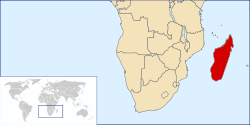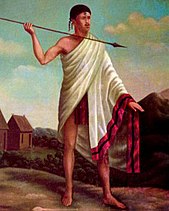Merina Kingdom
This article includes a list of general references, but it lacks sufficient corresponding inline citations. (January 2013) |
Merina Kingdom Fanjakan'Imerina | |||||||
|---|---|---|---|---|---|---|---|
| 1540–1897 | |||||||
 Location of the kingdom in Africa | |||||||
| Capital | Antananarivo | ||||||
| Common languages | Malagasy | ||||||
| Religion | Malagasy mythology, Protestantism (From 1869) | ||||||
| Government | Absolute monarchy | ||||||
| Historical era | Pre-colonial, Scramble for Africa | ||||||
• Establishment of the monarchy | 1540 | ||||||
| 1897 | |||||||
| |||||||
The Merina Kingdom (ca. 1540–1897) was a pre-colonial southeastern African state that dominated most of what is now Madagascar. It spread outward from Imerina, the central highlands region primarily inhabited by the Merina ethnic group with a spiritual capital at Ambohimanga and a political capital 24 kilometres (15 mi) west at Antananarivo, currently the seat of government for the modern democratic state of Madagascar. The Merina kings and queens who ruled over greater Madagascar in the 19th century were the descendants of a long line of hereditary Merina royalty, stretching back in oral traditions to such sources as the first human inhabitants of the island or the son of god himself.
History
The Merina people are a group within the Malagasy culture of Madagascar for whom the kingdom is named. A strong caste tradition in many parts of Madagascar saw rulers emerge among diverse ethnic groups, typically from the noble class known as andriana. Most notably, the Sakalava of the Western coastal plains established a thriving kingdom based on maritime trade with European and Arab commercial ships and pirates that dates to at least the 16th century.
The Merina lived within the island's central plateau called Imerina ("land seen from afar"). According to oral history, this land was originally inhabited by the Vazimba people, who were vanquished and largely expelled from the land by Merina king Andriamanelo in the 16th century, thereby establishing the Kingdom of Imerina.
A united and expanding Imerina was ruled by successors in his line. Political life on the island from the 16th century was characterized by sporadic conflict between the Merina and Sakalava kingdoms, originating with Sakalava slave hunting incursions into Imerina. King Andriamasinavalona quartered the kingdom to be ruled by his four favorite sons, producing persistent fragmentation and warfare between principalities in Imerina.

It was from this context in 1787 that Prince Ramboasalama, nephew of King Andrianjaka of Ambohimanga (one of the four kingdoms of Imerina) expelled his uncle and took the throne under the name Andrianampoinimerina. The new king used both diplomacy and force to reunite Imerina with the intent to bring all of Madagascar under his rule. This objective largely completed under his son, Radama I, who was the first to admit and regularly engage European missionaries and diplomats in Antananarivo.
The 33-year reign of Queen Ranavalona I, the widow of Radama I, was characterized by a struggle to preserve the cultural isolation of Madagascar from modernity, especially as represented by the French and British. Her son and heir, King Radama II, signed the unpopular Lambert Charter giving French entrepreneur Joseph-François Lambert exclusive rights to many of the island's resources. His liberal policies angered the aristocracy, however, and Rainivoninahitriniony, the prime minister, had the king strangled in a coup d'état. This aristocratic revolution saw Rasoherina, the king's widow, placed on the throne upon her acceptance of a constitutional monarchy that gave greater power to the Prime Minister. She replaced the incumbent Prime Minister with his brother, Rainilaiarivony, who retained the role until the Kingdom's collapse and married each successive queen. The next sovereign, Ranavalona II, converted the monarchy to Christianity and had all the sampy (ancestral royal talismans) burned in a public display. The kingdom's final ruler, Queen Ranavalona III, took the throne at age 22 and was exiled to Reunion and later Algeria following French colonization of the island in 1896.
French colonization

Angry at the cancellation of the Lambert Charter and seeking to restore property taken from French citizens, France invaded Madagascar in 1883 in what became known as the first Franco-Hova War (Hova as a name referring to the Merina aristocrats). At the war’s end, Madagascar ceded Antsiranana (Diégo Suarez) on the northern coast to France and paid 560,000 gold francs to the heirs of Joseph-François Lambert. In Europe, meanwhile, diplomats partitioning the African continent worked out an agreement whereby Britain, in order to obtain the Sultanate of Zanzibar, ceded its rights over Heligoland to the German Empire and renounced all claims to Madagascar in favor of France. The agreement augured ill for the primitive monarchy of Madagascar. Prime Minister Rainilaiarivory had succeeded in playing Great Britain and France against one another, but now France could meddle without fear of reprisals from Britain.
In 1895, a French flying-column landed in Mahajanga (Majunga) and marched by way of the Betsiboka River to the capital, Antananarivo, taking the city’s defenders by surprise since they had expected an attack from the much closer eastern coast. Twenty French soldiers died in combat and 6,000 died of malaria and other diseases before the second Franco-Hova War ended. In 1896, the Merina Kingdom was put under French protection as the Malagasy Protectorate and in 1897 the French Parliament voted to annex the island as a colony, bringing the Merina monarchy to a close.[1]
See also
- List of Malagasy monarchs
- List of colonial heads of Madagascar
- List of Presidents of Madagascar
- Prime Minister of Madagascar
References
- ^ Virginia Thompson, Richard Adloff. The Malagasy Republic: Madagascar today. Stanford University Press.
Bibliography
- Rabarioelina, Ndriana (Rev. Dr.) (2010), "Biblical Relations between Israel and Madagascar", Doctoral Thesis of Theology, SAHTS, États-Unis, 2010, 458 pages. Abstract in Saint-Alcuin House Journal, Volume 8, N°1, USA. And in Library of Congress, number ISSN 1548-4459, USA.
- Charlotte Liliane Rabesahala-Randriamananoro, Ambohimanga-Rova : approche anthropologique de la civilisation merina (Madagascar), Paris, Le Publieur, 2006, 393 p. (ISBN 2-85194-307-3. Texte remanié d’une thèse soutenue à l’Université de La Réunion en 2002. (French)
- Rajaonarimanana, Narivelo (1990), Savoirs arabico-malgaches : la tradition manuscrite des devins Antemoro Anakara (Madagascar), Institut national des langues et civilisations orientales. (French)
- Ramamonjy, Georges (1952), "De quelques attitudes et coutumes merina", dans Mémoires de l'Institut scientifique de Madagascar (Tananarive), série C, Sciences humaines, 1 (2), 1952, p. 181-196. (French)
- Ramilison, Emmanuel (Pastor) (1951), Andriantomara-Andriamamilazabe. Loharanon' ny Andriana nanjaka eto Imerina, Imprimerie Ankehitriny. (Malagasy)
- Randrianja Solofo, Ellis Stephen (2009), Madagascar. A short history, London, Hurst & Company, 2009.
- Raombana (l'historien) (1809-1855), "Histoires", Edition Ambozontany, Fianarantsoa, 3 Volumes. (French)
- Rasamimanana, Joseph (Dr.) (1909) et Louis de Gonzague Razafindrazaka (Governor), Ny Andriantompokoindrindra, Antananarivo, 50 pages. (Malagasy)
- Ravelojaona (Pastor) (1937-1970), Firaketana ny Fiteny sy ny Zavatra Malagasy, Encyclopedic Dictionary, Antananarivo, 5 Volumes. (Malagasy)
- Razafindrazaka, Harilanto, et alii (2009) "A new deep branch of eurasian mtDNA macrohaplogroup M reveals additional complexity regarding the settlement of Madagascar", BMC Genomics.
- Rombaka, Jacques Philippe (1963), Tantaran-drazana Antemoro-Anteony, Antananarivo, Imprimerie LMS, pp. 10–11. (French)
- Rombaka, Jacques Philippe (1970), Fomban-drazana Antemoro - usages et coutumes antemoro, Ambozontany, Fianarantsoa, 121 p. (French)
- Rebecca L. Green: Merina. The Rosen Publishing Group, New York, 1997, ISBN 0-8239-1991-9 (The heritage library of African peoples). Google Books
- Matthew E. Hules, et al. (2005). The Dual Origin of the Malagasy in Island Southeast Asia and East Africa: Evidence from Maternal and Paternal Lineages. American Journal of Human Genetics, 76:894–901, 2005.
- Mervyn Brown (2000). A History of Madagascar. Princeton: Markus Wiener Publishers. ISBN 1-55876-292-2.
- Stephen Ellis and Solofo Randrianja, Madagascar – A short history, London, 2009
- Brown, M. (1978) Madagascar Rediscovered: A History from Early Times to Independence (London: Damien Tunnacliff)
- Campbell, G. (1981) Madagascar and slave trade, 1850–1895, JAH
- Thompson, V. (1965) The Malagasy Republic: Madagascar today. Stanford University Press.

